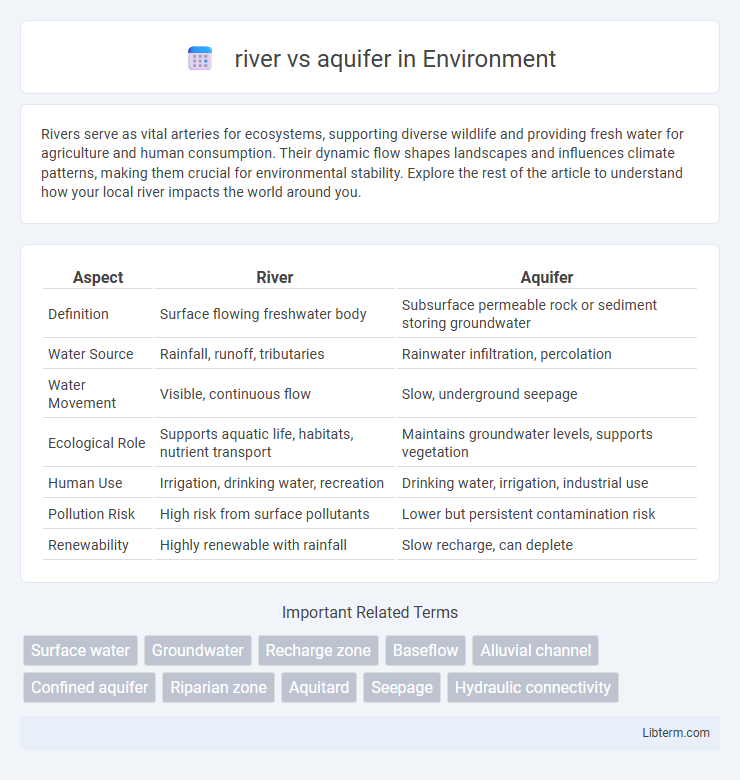Rivers serve as vital arteries for ecosystems, supporting diverse wildlife and providing fresh water for agriculture and human consumption. Their dynamic flow shapes landscapes and influences climate patterns, making them crucial for environmental stability. Explore the rest of the article to understand how your local river impacts the world around you.
Table of Comparison
| Aspect | River | Aquifer |
|---|---|---|
| Definition | Surface flowing freshwater body | Subsurface permeable rock or sediment storing groundwater |
| Water Source | Rainfall, runoff, tributaries | Rainwater infiltration, percolation |
| Water Movement | Visible, continuous flow | Slow, underground seepage |
| Ecological Role | Supports aquatic life, habitats, nutrient transport | Maintains groundwater levels, supports vegetation |
| Human Use | Irrigation, drinking water, recreation | Drinking water, irrigation, industrial use |
| Pollution Risk | High risk from surface pollutants | Lower but persistent contamination risk |
| Renewability | Highly renewable with rainfall | Slow recharge, can deplete |
Introduction: Understanding Rivers and Aquifers
Rivers are surface water bodies that flow continuously or seasonally, playing a crucial role in ecosystems and freshwater supply. Aquifers are underground layers of porous rock or sediment that store and transmit groundwater, essential for wells and irrigation. Both rivers and aquifers contribute significantly to the hydrological cycle and water availability.
Defining Rivers and Aquifers
Rivers are surface water bodies that flow continuously or seasonally, transporting freshwater across landscapes to oceans, lakes, or other rivers. Aquifers are underground layers of permeable rock or sediment saturated with groundwater, serving as natural reservoirs that store and transmit water. Understanding the distinction between rivers and aquifers highlights their roles in the hydrological cycle and water resource management.
Formation Processes: River vs Aquifer
Rivers form through the natural flow of surface water, shaped by precipitation, runoff, erosion, and the terrain's gradient, creating channels that continuously transport water toward larger bodies like oceans or lakes. Aquifers develop underground within porous rock, sand, or gravel layers, where water infiltrates and accumulates over long periods through processes like precipitation percolation and sediment deposition. The dynamic surface flow of rivers contrasts with the static, subterranean water storage mechanism that characterizes aquifers, highlighting distinct formation processes governed by hydrological cycles and geological structures.
Sources of Water: Surface vs Groundwater
Rivers are primary sources of surface water, flowing above ground and fed by precipitation, snowmelt, or springs, providing ecosystems and human activities with readily accessible water. Aquifers store groundwater below the Earth's surface in porous rock or sediment, replenished slowly by infiltrating rainwater, and serve as crucial reserves during dry periods or in regions lacking surface water bodies. Understanding the distinction between river and aquifer sources is essential for managing water resources sustainably and ensuring long-term water availability.
Water Flow and Movement
Rivers exhibit surface water flow characterized by visible, directional movement driven by gravity along defined channels. Aquifers contain groundwater that moves slowly through porous rock or sediment, with flow rates influenced by permeability and hydraulic gradients. Unlike rivers, aquifer water movement is diffused and often occurs below the earth's surface, making it less observable but critical for sustaining base flow in rivers and ecosystems.
Ecological Significance of Rivers and Aquifers
Rivers support diverse ecosystems by providing continuous flowing water essential for aquatic plants, fish, and wildlife habitats, maintaining nutrient cycling and sediment transport. Aquifers store vast quantities of groundwater that sustain baseflows in rivers during dry periods, ensuring long-term water availability and ecosystem resilience. Together, rivers and aquifers create interconnected hydrological networks critical for maintaining biodiversity, water quality, and ecological balance in terrestrial and aquatic environments.
Human Usage: Access and Consumption
Rivers provide immediate surface water access for irrigation, drinking, and industrial use, often requiring treatment due to contamination risks. Aquifers store vast underground freshwater reserves, supplying reliable water through wells especially during dry seasons or droughts, with slower recharge rates influencing sustainable withdrawal limits. Efficient management of both sources is essential to meet human consumption needs without depleting or polluting water supplies.
Sustainability and Recharge Rates
Rivers rely on surface water flow that fluctuates seasonally, impacting sustainability and making them vulnerable to droughts and overuse, whereas aquifers store groundwater with slower recharge rates dependent on precipitation infiltration. Sustainable management of rivers demands maintaining ecological flow to support biodiversity, while aquifer sustainability hinges on balancing extraction with natural recharge, which can take years to decades. Monitoring recharge rates using technologies like remote sensing and hydrogeological modeling is critical for preventing groundwater depletion and ensuring long-term water availability.
Pollution Risks and Challenges
Rivers face high pollution risks from surface runoff, industrial discharges, and sewage, leading to rapid contamination and ecosystem disruption. Aquifers are vulnerable to pollutants like agricultural chemicals and leaking landfills, with contamination spreading slowly but persisting for decades. Managing river pollution requires immediate intervention, while aquifer contamination poses long-term challenges due to difficult detection and remediation.
Conclusion: Choosing Between Rivers and Aquifers
Rivers provide surface water that is readily accessible but subject to seasonal fluctuations and pollution risks. Aquifers offer a more stable, reliable source of groundwater with less surface contamination, making them ideal for long-term water supply. Decision-making between rivers and aquifers depends on regional climate, water demand, and sustainability considerations.
river Infographic

 libterm.com
libterm.com